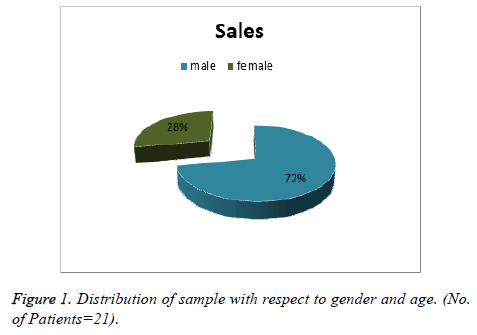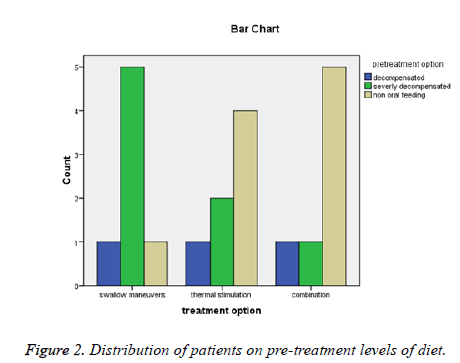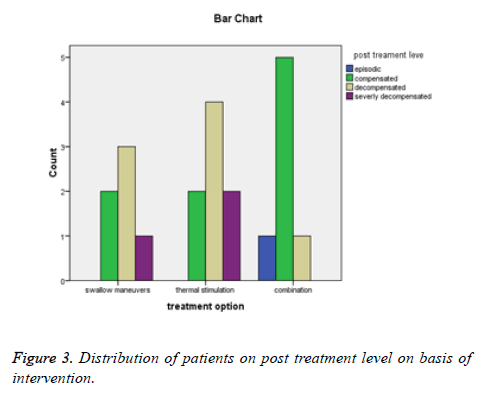ISSN: 0970-938X (Print) | 0976-1683 (Electronic)
Biomedical Research
An International Journal of Medical Sciences
Research Article - Biomedical Research (2017) Volume 28, Issue 4
Effectiveness of swallow maneuvers, thermal stimulation and combination both in treatment of patients with dysphagia using functional outcome swallowing scale
1Department of Speech and Language Pathology, Riphah College of Rehabilitation Science Lahore, Riphah International University, Islamabad, Pakistan
2Department of Speech and Language Pathology, Combine Military Hospital, Lahore, Pakistan
3Dow University of Health Sciences, Karachi, Pakistan
- *Corresponding Author:
- Sumera Nawaz Malik
Department of Speech and Language Pathology
Riphah College of Rehabilitation Science
Riphah International University, Pakistan
Accepted date: August 5, 2016
Objective: To explore the better treatment option among thermal stimulation, swallow maneuvers and the combination of both options for treatment of patients with dysphagia.
Material and Method: An experimental study was conducted to find the better treatment option among thermal stimulation and swallow maneuvers for treatment of the patients with dysphagia. Three groups A, B and C were made, patients were taken through purposive sample technique and groups were allocated using dice roll method. Group A received thermal stimulation, B group had swallowing maneuvers and group C is given the combination of both. Outcomes were measured through the Function Outcome Swallowing Scale (FOSS). Data was collected from tertiary care units in Lahore and analysed by SPSS 16.
Results: Groups A, B and C are given thermal stimulation, swallow maneuvers and combination of both treatment options as a treatment option respectively. More beneficial results are seen in the C group, which was given the combination of swallow maneuvers and thermal stimulation.
Conclusion: On the basis of results is concluded that combination of thermal stimulation and swallow maneuvers are significantly more fruitful for the treatment of dysphagia.
Keywords
Swallow maneuvers, Dysphagia, Thermal stimulation, Dysphagia management
Introduction
Trouble in swallowing food; solid, semi -solid, liquid, or any of them is defined as dysphagia. Swallowing issues can be due to neurological, muscular, anatomical and psychological disturbances [1]. Normal swallowing process has four sequential stages, include oral preparatory, oral propulsive, pharyngeal and oesophageal stages, on the basis of the bolus location in the food passage [2]. Oral phase, pharyngeal phase and oesophageal phase are physiological phases of swallowing that can present symptoms of dysphagia. Common symptoms comprise of generalized feeding difficulty i.e. Poor competence, failure to thrive, and food refusal, however, specific symptoms include tongue thrust, oxygen desaturation, choking, and cough [3]. Complication with normal swallowing pattern can not only lead to impaired quality of life but also have significant life threatening outcomes. In oropharyngeal dysphagia, aspiration of food, liquid and even saliva is seen frequently and can lead to aspiration pneumonia. If dysphagia remains untreated then it can cause many other problems which may include: hindrance in physical and mental growth, choking, dehydration, aspiration pneumonia, malnutrition, asphyxiation, chronic pain, unpleasant socio-emotional effects and ultimately death [4]. As it is known that the factors like neurological, muscular, anatomical or physiological are most of the time responsible for predisposing a person to swallowing difficulty [1]. Among these etiologies stroke is the most common risk factor. There are many other conditions are there that can lead an individual to paradigm of dysphagia e.g. poor co-ordination of muscular strength, stance, size of bolus, illness making disuse of swallow, ageing, cognition, respiratory and cardiac issues, furthermore, they may have a significant influence on initiating and progression of swallowing process [4].
Therapeutic strategies and the results of rehabilitation in oropharyngeal dysphagia had been considered since the 70’s, reaching its elevated point throughout the 80’s and 90’s [5]. Several techniques are used to modify the physiology of the swallow. One of them is thermal stimulation that includes tapping or rubbing technique the patient's anterior faucial pillar with the use of an iced dental mirror. Other therapeutic techniques include oral-motor exercises and swallow maneuvers e.g. super glottis swallow, supra supra-glottic swallow, Mendelsohn meneuvers, effortful swallow and masako maneuvers [6].
Thermal tactile stimulation also, known as thermal application is one type of therapy used for the treatment of swallowing disorders. This method involves stroking or rubbing the anterior faucial pillars with a cold probe prior to having the patient swallow. It is hypothesized that the touch and cold stimulation increases oral awareness and provides "an alerting sensory stimulus to the cortex and brainstem such that, when the patient initiates the oral stage of swallow, the pharyngeal swallow will trigger more rapidly" [7].
For improvement of quality and quantity of life, there is immediate need of rehabilitation, for this purpose, this study was conducted to see the better therapeutic option for treatment of dysphagia.
Material and Methods
Methodology
Study was conducted on consecutive outpatient from tertiary care units (Combined Military Hospital, Fatima Memorial Hospital and Mayo Hospital), age range of 45 years to 65 years only those patients (both male and female) were integrated in the research with predetermined criteria: having difficulty to swallow due to acquired neurological conditions specifically involving sub-cortical area or brain stem, scoring mild to moderate on Glasgow coma scale. Patients with degenerative diseases and oesophageal dysphagia were excluded.
Study was conducted and completed within 6 months: 1st January to 30th June 2014, patients were selected through purposive sampling and groups were allocated through dice roll method. Group A received thermal stimulation, B group had swallow maneuvers and C group took combination of the both the thermal stimulation and swallow maneuvers as a treatment option. Outcomes were measured through the Functional Out Swallowing Scale (FOSS). Thermal stimulation was given for 4-5 sec in thrice a day and maneuvers were performed 5-10 times in a session thrice a day and the patient was re-evaluated after 20 consecutive sessions. Main types of maneuvers applied were: the Mendelsohn maneuvers, Effortful swallow and Supraglottal swallow.
Data analysis procedure
SPSS-16 is used for statistical analysis. Endnote is used for the purpose of referencing citations.
Results
Distribution of sample size indicates that there were 28% females and 72% male in sample as shown in Figure 1. Frequency distribution of gender among groups shows that there were 5 males and 2 females in each group mean age of patients in Group A, Group B and Group C were 59.71 years, 57 years and 57.3 years respectively are shown in Table 1.
| Group of patients | Frequency | Percent | Valid percent | Cumulative percent |
|---|---|---|---|---|
| Group A | Male | 5 | 71.4 | 71.4 |
| Female | 2 | 28.6 | 28.6 | |
| Total | 7 | 100 | 100 | |
| Group B | Male | 5 | 71.4 | 71.4 |
| Female | 2 | 28.6 | 28.6 | |
| Total | 7 | 100 | 100 | |
| Group C | Male | 5 | 71.4 | 71.4 |
| Female | 2 | 28.6 | 28.6 | |
| Total | 7 | 100 | 100 |
Table 1. Frequency distribution of gender between groups.
Patients were included in three groups having different interventional approaches; thermal stimulation (Group A), swallow maneuvers (Group B) and combination of both thermal stimulation and swallow maneuvers (Group C). Patient allocated through random sampling technique in each group. In Group A: 4 patients were on 5 level, 2 patients on 4 level and 1 patient on 3 level, however, in Group B; 5 patients were on 4 level and 1, 1 patients on 4 level and 3 level respectively and in Group C, 5 patients were on 5 level and 1, 1 patient on 4 level and 3 level respectively as shown in Figure 2.
Post-treatment cross tabulation showed that after 20 consecutive sessions Group A; 4 patients were on 3 level, 2 patients on 2 level and only 1 patient on 4 level. In Group B; 3 patients were on 3 level, 2 patients on 4 level and 2 patients on 2 level. In group C; 5 patients were on 2 level and 1, 1 patient on 1 and 3 level respectively as shown in Figure 3.
Statistical analysis
It showed P value 0.257 (>0.05), it depicts that efficacy of the treatment options are statistically insignificant.
Discussion
Etiological cause of dysphagia in 95% patients was stroke, among the patients involved in study the 72% were with the diabetes, 100% with hypertension and 28% were with cardiac diseases. According to Shford et al. effortful swallow maneuvers appears to be a therapeutic source in the rehabilitation of oropharyngeal dysphagia [8] Another study concluded that 55% of patients showed escape from risk of aspiration through the chin down posture, among them 40% were with pre swallow aspiration and 60% were with aspiration while swallowing [9]. Current study has showed notable results in favour of swallow maneuvers for not only prevention of aspiration but also in improving the dietary status of the patients with dysphagia.
Oral sensory stimulation techniques, swallow maneuvers, maxillofacial prosthesis, medicines and surgery are part of direct therapy and are intended to change the physiology of the swallowing process [10]. In Japan ice massage is in tremendous use as a treatment to initiate the swallow process, even in daily basis swallow training among CVA and stroke patients and the results told that immediate triggering of swallow reflex is seen through ice massage [11]. In this study icing massage also had a significant result in triggering the swallowing reflex and management of dysphagia. During the process of swallow in normal human being, primary motor, somatosensory along with sensory motor area are activated. Activation of different cortical areas during different eating and swallowing tasks depicts that different areas are aligned to different tasks. That’s why; different sites of oral cavity are stimulated for the stimulation of the respected cortical area [12,13]. Similar results are proved by this study, 58% patients were able to achieve the level of decompensated dietary level after thermal stimulation as treatment, 30% were on compensated level and only 14% were on severely decompensated level of Functional Out Swallowing Scale (FOSS).
A study conducted in America to see the effects of thermal stimulation and chemical stimulation on liquid swallow in healthy and stroke population It was concluded that combined thermal and chemical stimulation alters swallow mechanism behaviour in healthy as well as stroke population [14]. Efficacy of combined thermal stimulation and electrical stimulation is also documented by Lim et al. [15]. In light of above mentioned results it is evident that thermal stimulation in combination with other treatment options is proved to be more beneficial. Likewise this study has showed better results with combination of thermal stimulation and swallows maneuvers. Although no such evidence is available that could prove the efficacy of the combination of the thermal stimulation and swallow maneuvers but literature have proved that thermal stimulation in combination with other stimulations are better than the single approach intervention.
Conclusion
On the basis of results of the study it is concluded that combination of thermal stimulation and swallow maneuvers is better than the solo thermal stimulation application or swallow maneuvers practice. It is evident from literature that thermal stimulation in combination with other treatment options is proved to be more beneficial. Likewise this study has showed better results with combination of thermal stimulation and swallows maneuvers.
Recommendation
For generalizing the fact that stimulation and maneuvers in combination have better outcome in management of dysphagia, this study should be conducted on large scale. On large sample size, large population and more combination of more treatment techniques. Different treatment options and their combinations should be explored. There is an immense need of the minimizing the confounding variables and effect of weather, regional differences and socioeconomic status should also be taken into consideration.
Acknowledgement
The coordinating services of my teachers Mr. Arshad Mehmood Naz, Madam Ayesha Kamal Butt and Dr. Rashid Hafiz Nasir for their keen interest, useful suggestions together with the meaningful comments and cooperation deserve special mention here. My warm appreciation is cordially extended Fazaila Ehsan, Hena Arshad, Sidra and Qura-tul-ain for providing me with useful and informative materials.
References
- Wieseke A, Bantz D, Siktberg L, Dillard N. Assessment and early diagnosis of dysphagia. Geriatr Nurs 2008; 29: 376-383.
- Matsuo K, Palmer JB. Coordination of Mastication, Swallowing and Breathing. Jpn Dent Sci Rev 2009; 45: 31-40.
- Dusick A. Investigation and management of dysphagia. Pediat neurol Elsevier 2003.
- Enderby P, Pickstone C, John A, Fryer K, Cantrell A, Papaioannou D. Resource manual for commissioning and planning service for SLCN. Royal College of Speech and Language Therapists 2009.
- Silva RG. Efficacy of rehabilitation in oropharyngeal dysphagia. Pro Fono 2007; 19: 123-130.
- Dilworth C. The role of the speech language pathologist in acute stroke. Ann Ind Acad Neurol 2008; 11: 108.
- Henshaw LJ. Dysphagia: A Comparison of treatment effectiveness 2012.
- Ashford J, McCabe D, Wheeler-Hegland K, Frymark T, Mullen R, Musson N. Evidence-based systematic review: Oropharyngeal dysphagia behavioural treatments. Part III-impact of dysphagia treatments on populations with neurological disorders. J Rehab Res Develop 2009; 46.
- Humbert IA, Joel S. Tactile, gustatory, and visual biofeedback stimuli modulate neural substrates of deglutition. Neuroimage 2012; 59: 1485-1490.
- Logemann JA. Approaches to management of disordered swallowing. Baillieres Clin Gastroenterol 1991; 5: 269-280.
- Nakamura T, Fujishima I. Usefulness of ice massage in triggering the swallow reflex. J Stroke Cerebrovasc Dis 2013; 22: 378-382.
- Mosier K, Patel R, Liu WC, Kalnin A, Maldjian J. Cortical representation of swallowing in normal adults: functional implications. Laryngoscope 1999; 109: 1417-1423.
- Kaatzke-McDonald MN, Post E, Davis PJ. The effects of cold, touch, and chemical stimulation of the anterior faucial pillar on human swallowing. Dysphag 1996; 11: 198-206.
- Hamdy S, Jilani S, Price V, Parker C, Hall N, Power M. Modulation of human swallowing behaviour by thermal and chemical stimulation in health and after brain injury. Neurogastroenterol Motil 2003; 15: 69-77.
- Lim KB, Lee HJ, Lim SS, Choi YI. Neuromuscular electrical and thermal-tactile stimulation for dysphagia caused by stroke: a randomized controlled trial. J Rehab Med 2009; 41: 174-178.


